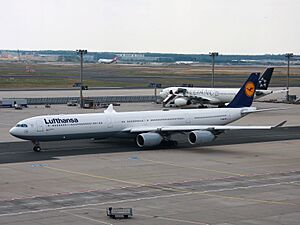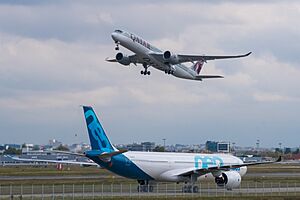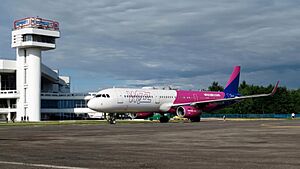Airbus facts for kids
 |
|
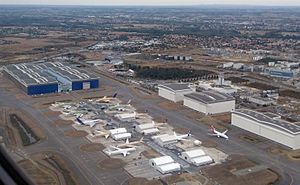
Lagardère production plant in Blagnac, France
|
|
|
Formerly
|
|
|---|---|
| Public | |
| Traded as | |
| ISIN | NL0000235190 |
| Industry |
|
| Predecessor | Aérospatiale, EADS CASA, DASA, Matra |
| Founded | 18 December 1970 |
| Headquarters |
|
|
Area served
|
Worldwide |
|
Key people
|
|
| Products | |
| Revenue | |
|
Operating income
|
|
| Total assets | |
| Total equity | |
| Owner |
|
|
Number of employees
|
156,921 (2024) |
| Divisions |
|
| Subsidiaries |
|
| Footnotes / references Financials as of 31 December 2024[update]. References: |
|
Airbus SE is a big European company that designs and builds airplanes. It also has separate parts that make things for defense and space and helicopters. Airbus has been the world's top helicopter maker for a long time. In 2019, it also became the biggest maker of passenger airplanes.
The company started in 2000. It was called the European Aeronautic Defence and Space Company (EADS). This happened when French, German, and Spanish aerospace companies joined together. Later, EADS took full control of its airplane-making part, Airbus Industrie GIE. This part was first created in 1970 to build a large airplane to compete with American ones. EADS changed its name to Airbus SE in 2015. Because it started in many countries, Airbus has offices and factories in France, Germany, Spain, and the United Kingdom. It also has newer locations in Canada, Malaysia, United States, Morocco, and India.
Airbus' main office is in Blagnac, France. Its legal headquarters are in Leiden, Netherlands. The company is led by CEO Guillaume Faury. Its shares are traded on major stock exchanges in Paris, Frankfurt, and Spain.
Contents
How Airbus Started and Grew
Today's Airbus company came from many European aerospace companies joining together. The Airbus Industrie GIE group started in 1970. In 2000, the European Aeronautic Defence and Space Company (EADS) was formed. EADS owned 100% of Eurocopter SA (started in 1992) and 80% of Airbus Industrie GIE.
In 2001, Airbus Industrie GIE became Airbus SAS, a simpler company. In 2006, EADS bought the remaining 20% of Airbus from BAE Systems. EADS changed its name to Airbus Group in 2014 and then to Airbus SE in 2015. In 2017, the company was given its current name, Airbus SE.
| Airbus (est. 2000, renamed 2017) |
|
||||||||||||||||||||||||
The logos of Airbus have changed over time. Early logos had a symbol like a jet engine turbine. This design was also used on Airbus airplanes. The EADS logo from 2000 to 2010 combined symbols from the companies that merged. Later, a new font was chosen for the logos of Airbus Group and then Airbus SE.
-
Original logo for the Airbus A300
What Airbus Makes
Passenger Airplanes
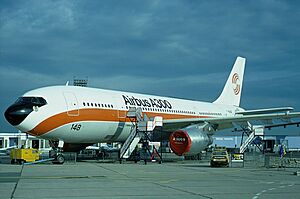
Airbus started making airplanes with the A300 in 1972. This was the world's first large, two-engine airplane. It became very popular after new rules in 1976 allowed two-engine planes to fly farther from airports. This made the A300 more efficient for long flights over oceans.
Next, they made the Airbus A310, a smaller wide-body plane. Airbus saw that airlines needed a plane smaller than the A300. The A310 was built from 1981 to 1998.
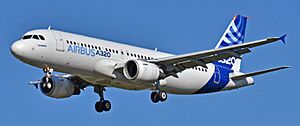
After the A300's success, Airbus developed a smaller, narrow-body plane and more wide-body planes. The narrow-body effort led to the A320 in 1987. This plane was a huge success. The A320 was the first commercial jet to use a digital "fly-by-wire" control system. This means computers help control the plane. All Airbus planes made since then have similar cockpit systems, which makes it easier for pilots to learn to fly different models.
Because the A320 was so popular, Airbus made longer versions like the A321 (in 1993) and shorter ones like the A319 (in 1995) and A318 (in 2002). In 2016, Airbus updated this family of planes with new engines, calling them the A320neo (meaning "new engine option").
The wide-body program brought the four-engine A340 in 1991 and the two-engine A330 in 1992. Airbus wanted to offer four-engine planes for very long flights. However, new rules allowed two-engine planes to fly even farther. This helped the A330 a lot, but sales of the A340 were affected. Production of the A340 ended in 2011. The A330 was updated with new engines in 2018, becoming the A330neo.
The world's largest passenger plane, the A380, was introduced by Airbus in 2005. It has four engines and two full decks for passengers. It was meant to compete with the Boeing 747. However, the A380 cost a lot to develop and didn't sell as well as hoped because it was expensive to operate. Production of the A380 ended in December 2021.
The A350, a wide-body, two-engine plane, came out in 2013. It was the first Airbus plane made mostly from strong, lightweight carbon fiber materials. It is longer and wider than earlier Airbus wide-body planes.
In 2018, Airbus added another narrow-body jet, the A220. Airbus took over the program from Bombardier and renamed it. The A220 has five seats across in each row, while the A320 has six.
In 2024, Airbus delivered 766 aircraft to its customers. This was a 4% increase from the year before. This helped Airbus keep its spot as the world's leading aircraft maker.
| Aircraft | Description | Typical seating | First flight | Last delivery | Orders | Deliveries | Unfilled | In operation |
|---|---|---|---|---|---|---|---|---|
| A220 | 2 engines, narrow-body | 100–150 | 16 September 2013 (as the Bombardier CSeries) | 944 | 430 | 514 | 430 | |
| A300 | 2 engines, wide-body | 228–254 | 28 October 1972 | 12 July 2007 | 561 | 561 | — | 209 |
| A310 | 2 engines, wide-body | 190-230 | 3 April 1982 | 15 June 1998 | 255 | 255 | — | 48 |
| A320 | 2 engines, narrow-body | 107–185 | 22 February 1987 | 19,282 | 12,097 | 7,185 | 11,133 | |
| A330 | 2 engines, wide-body | 246–300 | 2 November 1992 | 1,926 | 1,637 | 289 | 1,469 | |
| A340 | 4 engines, wide-body | 210–370 | 25 October 1991 | 16 July 2010 | 377 | 377 | — | 187 |
| A350 | 2 engines, wide-body | 300–410 | 14 June 2013 | 1,429 | 663 | 766 | 662 | |
| A380 | 4 engines, wide-body, double deck | 555–853 | 27 April 2005 | 16 December 2021 | 251 | 251 | — | 216 |
| Data as of 30 June 2025. | ||||||||
Airbus also owns half of the ATR company. ATR builds smaller regional planes called the ATR 42 and ATR 72.
Private and Business Jets

Airbus Corporate Jets sells and changes new planes for private and business customers. These planes are similar to the commercial ones Airbus offers. Airbus entered the business jet market in 1997 with the A319 Corporate Jet. This was after Boeing introduced its 737-based business jet. The term "Airbus Corporate Jet" is now used for all their business models, including the larger VIP wide-body planes.
Airbus also owns 10% of Dassault Aviation. This company builds smaller business jets called the Falcon family.
Military Aircraft
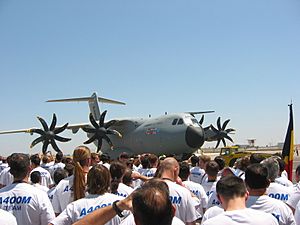
Airbus Defence and Space sells and builds or changes new planes for military use. Airbus became more interested in military aviation in the late 1990s. They focused on two main areas:
- Aerial refueling: With planes like the Airbus A310 MRTT and later the Airbus A330 MRTT. These planes can refuel other aircraft in the air.
- Tactical airlift: With the Airbus A400M Atlas. This plane carries troops and cargo.
The A310 and A330 MRTT planes are changed versions of passenger airliners. They are called "multi-role tanker transports" because they can refuel, transport troops, carry injured people (medevac), and move cargo.
The A400M Atlas is a four-engine, propeller-driven transport plane. It is bigger than the American C-130 but smaller than the C-17. It can carry heavier loads than the C-130. Its propeller engines allow it to use rough landing strips. The A400M was made for European NATO countries like France, Germany, and the UK. It was meant to be an alternative to relying on foreign aircraft. The first A400M was delivered to the French Air Force in 2013. By 2023, over 100 of these planes had been built.
The Defence and Space part of Airbus also sells and puts together the EADS CASA C295. This is a smaller transport plane that was first designed by the Spanish company CASA.
Airbus also has shares in other companies that make military products:
- 50% of ArianeGroup, which builds the Ariane 5 space rockets.
- 46% of Eurofighter, which builds the Typhoon fighter jet.
- 42.5% of Panavia Aircraft, which built the Tornado fighter jet.
- 37.5% of MBDA, which builds missiles.
- 10% of Dassault Aviation, which builds the Rafale fighter jet.
Helicopters
Airbus Helicopters sells and builds new rotorcraft (helicopters) for civilian and military use. This part of the company started in 1992 as the Eurocopter Group. It was formed by merging the helicopter parts of Aérospatiale and DASA. Airbus Helicopters is a leader in the helicopter industry.
Their civilian helicopters include:
- Single-engine: H125 and H130
- Light twin-engine: H135 and H145
- Medium twin-engine: H155 and H160
- Super medium twin-engine: H175
- Heavy twin-engine: H215 and H225
Military helicopters include the Tiger attack helicopter. They also make military versions of many of their civilian models.
Airbus also owns 62.5% of the NHIndustries company. This company builds the NH90 military utility helicopter.
How Airbus is Organized
Main Divisions
Revenues by division, as of 2023: Commercial aircraft (72%) Defence and Space (17%) Helicopters (11%)
Commercial Aircraft Division
The Commercial Aircraft division makes passenger planes. In 2023, this part of Airbus made 72% of the company's total money. Here are some key numbers for this division:
| Revenue (€ b) |
Operating income (€ b) |
Value of order book (€ b) |
Unfulfilled orders |
Net order intake |
Aircraft deliveries |
Number of employees |
|
|---|---|---|---|---|---|---|---|
| 2016 | 49.2 | 1.5 | 1,010 | 6,874 | 731 | 688 | 73,852 |
| 2017 | 43.4 | 2.2 | 950 | 7,265 | 1,109 | 718 | 74,542 |
| 2018 | 47.9 | 4.2 | 411 | 7,577 | 747 | 800 | 80,924 |
| 2019 | 54.7 | 1.7 | 424 | 7,482 | 768 | 863 | 80,985 |
| 2020 | 34.2 | −1.3 | 324 | 7,184 | 268 | 566 | 78,487 |
| 2021 | 36.1 | 4.1 | 345 | 7,082 | 507 | 611 | 73,560 |
| 2022 | 41.4 | 4.8 | 390 | 7,239 | 820 | 661 | 79,134 |
| 2023 | 47.7 | 3.6 | 490 | 8,598 | 2,094 | 735 | 90,032 |
Defence and Space Division
The Airbus Defence and Space division was created in 2014. It combines the former Airbus Military, Astrium, and Cassidian divisions. This part of the company makes military planes, space systems, and security systems. For example, it helps build parts for the Ariane rockets and the Galileo satellite system.
Helicopters Division
Airbus Helicopters, once known as Eurocopter, makes and supports helicopters. It is a leading company in the helicopter industry.
|
Structural evolution of Airbus SE
|
|||||||||||||
| Dec 1970 | Jan 1992 | July 2000 | Sep 2000 | Jan 2001 | Dec 2006 | Apr 2009 | Sep 2010 | Jan 2014 | May 2015 | Jan 2017 | Apr 2017 | ||
| European Aeronautic Defence and Space Company NV | Airbus Group NV | Airbus Group SE | Airbus SE | ||||||||||
| Airbus Industrie GIE | Airbus SAS | ||||||||||||
| Airbus Military SAS | Airbus Defence and Space SAS | ||||||||||||
| EADS Defence and Security | Cassidian SAS | ||||||||||||
| Astrium SAS | EADS Astrium SAS | ||||||||||||
| Eurocopter SA | Eurocopter SAS | Airbus Helicopters SAS | |||||||||||
Other Companies Airbus Owns or Works With
Airbus has many other companies it owns or works with:
- AirBusiness Academy
- Airbus Flight Academy
- Airbus Group, Inc. (the US part of Airbus)
- Airbus Transport International (a cargo airline that moves Airbus parts)
- NAVBLUE
- Premium AEROTEC
- Satair
- Airbus Atlantic
Joint Ventures
Airbus also works with other companies in joint ventures:
| Name | Airbus' Share | What they do |
|---|---|---|
| Airbus Canada Limited Partnership |
75%
|
Makes the Airbus A220 airplanes |
| ArianeGroup |
50%
|
Makes Ariane 5 and Ariane 6 space rockets |
| ATR |
50%
|
Makes ATR 42 and ATR 72 regional planes |
| Dassault Aviation |
10.53%
|
Makes Rafale fighter jets and Falcon business jets |
| Eurofighter |
46%
|
Makes the Typhoon fighter jet |
| MBDA |
37.5%
|
Makes missile systems |
| NHIndustries |
62.5%
|
Makes the NH90 military helicopter |
| Panavia Aircraft |
42.5%
|
Made the Tornado fighter jet |
The largest shareholders of Airbus in early 2024 were:
- Government of France (10.83%)
- Government of Germany (10.82%)
- Government of Spain (4.081%)
Airbus Leadership
The main leaders of Airbus are:
- Chairman: René Obermann (since April 2020)
- Chief Executive: Guillaume Faury (since April 2019)
- Past Chairmen
- Franz Josef Strauss (1970–1988)
- Edzard Reuter (1994–1998)
- Jürgen E. Schrempp (1998–2000)
- Manfred Bischoff (2000–2007)
- Arnaud Lagardère (2007–2013)
- Denis Ranque (2013–2019)
- Past Chief Executives
- Henri Ziegler (1970–1975)
- Bernard Lathière (1975–1984)
- Jean Pierson (1985–1998)
- Noël Forgeard (1998–2005)
- Gustav Humbert (2005–2006)
- Christian Streiff (2006)
- Louis Gallois (2006–2012)
- Tom Enders (2012–2019)
Where Airbus Builds Things
Airbus has several places where it puts together its planes:
- Toulouse, France (A320 family, A330 and A350)
- Airbus Hamburg-Finkenwerder, Hamburg, Germany (A320 family)
- Seville, Spain (A400M and C295)
- Tianjin, China (A320 family)
- Airbus Mobile, Mobile, Alabama, United States (A220 and A320 family)
- Mirabel, Quebec: Airbus Canada (A220)
Airbus also has many other factories in Europe. This is because it started as a group of different companies. For planes built in Europe, parts often move between factories using special planes called the Beluga and BelugaXL. These planes can carry whole sections of an airplane body. For planes built in China and the United States, parts are gathered in Europe and then shipped to the assembly lines.
Airbus opened a factory for the A320 family of planes in Tianjin, China, in 2009. In 2022, the Tianjin plant was updated to build the A321. In 2023, construction began to add a second production line there.
North America is very important for Airbus. Many Airbus planes are sold to customers there. Also, many US companies supply parts for Airbus planes. This supports many jobs and brings in billions of dollars. For example, a version of the A380 has 51% American-made parts.
Airbus announced plans for a factory in Mobile, Alabama, in 2012. This factory builds the A220, A319, A320, and A321 planes. Construction started in 2013, and the factory began operating in 2015. It can produce up to 50 planes each year.
In December 2024, Airbus leased a large office space in Bengaluru, India. This new Global Capacity Centre will help Airbus grow its presence in India.
Airbus' Money Matters
Here are some key financial numbers for Airbus SE each year:
| Revenue (€ b) |
Net profit (€ b) |
Research and development expenses (€ b) |
New orders (€ b) |
Order backlog (€ b) |
Number of employees (k) |
References | |
|---|---|---|---|---|---|---|---|
| 2004 | 31.7 | 1.3 | 2.1 | 44.1 | 184 | 110 | |
| 2005 | 34.2 | 1.7 | 2.0 | 92.5 | 253 | 113 | |
| 2006 | 39.4 | 0.19 | 2.4 | 69.0 | 262 | 116 | |
| 2007 | 39.1 | −0.43 | 2.6 | 136 | 339 | 116 | |
| 2008 | 43.2 | 1.6 | 2.6 | 98.6 | 400 | 118 | |
| 2009 | 42.8 | −0.72 | 2.8 | 45.8 | 389 | 119 | |
| 2010 | 45.7 | 0.58 | 2.9 | 83.1 | 448 | 121 | |
| 2011 | 49.1 | 1.1 | 3.1 | 131 | 540 | 133 | |
| 2012 | 56.4 | 1.1 | 3.1 | 102 | 566 | 140 | |
| 2013 | 59.2 | 1.4 | 3.1 | 218 | 686 | 144 | |
| 2014 | 60.7 | 2.3 | 3.4 | 166 | 857 | 138 | |
| 2015 | 64.4 | 2.6 | 3.4 | 159 | 1,005 | 136 | |
| 2016 | 66.5 | 0.99 | 2.9 | 134 | 1,060 | 133 | |
| 2017 | 66.7 | 2.8 | 2.8 | 158 | 997 | 129 | |
| 2018 | 63.7 | 3.0 | 3.2 | 55.5 | 459 | 133 | |
| 2019 | 70.4 | −1.3 | 3.3 | 81.1 | 471 | 134 | |
| 2020 | 49.9 | −1.1 | 2.8 | 33.2 | 373 | 131 | |
| 2021 | 52.1 | 4.2 | 2.7 | 62.0 | 398 | 126 | |
| 2022 | 58.7 | 4.2 | 3.0 | 82.5 | 449 | 134 | |
| 2023 | 65.4 | 3.7 | 3.2 | 186 | 553 | 147 |
In April 2013, Daimler sold its shares in EADS. As of December 31, 2024, most of Airbus Group stock is traded publicly. The French, German, and Spanish governments own a significant part of the company through special partnerships.
In April 2020, Airbus announced that it had cut airplane production by a third. This was due to the COVID-19 pandemic. The company's CEO, Guillaume Faury, said Airbus was "bleeding cash at an unprecedented speed." This situation meant the company had to make deep job cuts.
Airbus and the Environment
Airbus is working towards "Flightpath 2050." This is a plan for the aviation industry to reduce noise and pollution from airplanes. Airbus was the first aerospace company to get an ISO 14001 certification in 2007. This certification shows that the whole company meets high environmental standards.
Developing Cleaner Fuels
Airbus has worked with companies like Honeywell and JetBlue to develop aviation biofuel. This fuel helps reduce pollution and the need for fossil fuels. They believe it could replace up to a third of the world's aviation fuel. Biofuel made from algae, for example, absorbs carbon dioxide as it grows. This means it doesn't add new carbon to the air. It also doesn't compete with food production. While these fuels are still being developed, Airbus offers delivery flights using a 10% biofuel mix in regular engines. This shows that the fuel can be used in commercial flights without changing the engines.
In July 2024, Airbus and Airports Council International (ACI) World signed an agreement. They will work together to reduce aviation's environmental impact. This includes using more sustainable aviation fuel (SAF).
Hydrogen-Powered Aircraft Ideas
In September 2020, Airbus showed off three "ZEROe" concept planes. These planes would run on liquid hydrogen. Airbus believes these could be the first commercial zero-emission aircraft. They hope these planes could start flying by 2035. One design includes an aircraft with six removable turbo-prop motors.
At the Airbus Summit in March 2025, Airbus shared updates on its hydrogen-powered ZEROe aircraft development.
More About Airbus
- Airbus Training Centre Europe
- Competition between Airbus and Boeing
- Competition in the regional jet market
- Embraer
- Liebherr Aerospace





